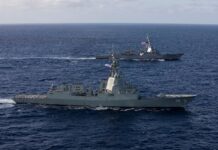 AN INDIAN submarine came close to firing on an unidentified N-sub during the 1971 India-Pakistan war. In a stunning revelation about the conflict in a book written by a retired Indian Navy submariner, an Indian submarine had a brush with a hitherto unidentified nuclear submarine near Pakistani shores.
AN INDIAN submarine came close to firing on an unidentified N-sub during the 1971 India-Pakistan war. In a stunning revelation about the conflict in a book written by a retired Indian Navy submariner, an Indian submarine had a brush with a hitherto unidentified nuclear submarine near Pakistani shores.
According to the book Foxtrots of the Indian Navy, by Commodore PR Franklin (Retd) who has fictionalised the names of the vessels and the personnel, the Indian submarine was ready to fire and was within striking distance but refrained from attacking since the other vessel could not be positively identified and also drifted off on its own.
The book narrates various accounts of the now decommissioned Soviet Union-built Foxtrot-class submarines the IN used. While it is known that the Arabian Sea often saw nuclear submarines from naval teams of the US, Britain, France and Russia, the origin of the said nuclear submarine ¬¬– which was confirmed to be nuclear-powered based on its “sonar acoustic signature” – could never be ascertained.
As per the book, the submarine, while on patrol during the war in 1971, picked up a “contact” on its sonar while closing in on her. Both then engaged in complex manoeuvres around each other. It is pertinent to note that Indian submarines were under strict orders to positively identify targets as enemy assets before attacking them.
According to excerpts from the book made available to this newspaper, the Indian submarine has been identified as Vanshali, a name arrived at by anagramming letters from the names of the eight submarines in the class.
“It was classified as a platform being driven by steam turbines. All propulsion systems have their own signatures… Steam turbines are distinctive by their characteristics. The Sonar Officer reported details to the Captain… It was closing Vanshali. The Captain took Vanshali up to periscope depth again, for the second time… This was to identify the target in accordance with Higher Directives… Two bow tubes housing anti submarine torpedoes, and two housing anti-shipping torpedoes were made ready to fire at short notice. Since the contact was not identified, and since Vanshali was in hostile territory, any firing on her part could only be reactive, and in self-defence,” an excerpt from the book reads.
While the Vanshali went into “ultra-quiet” mode and stopped her propulsion, the officers and crew on board are described as having had “butterflies in their stomachs”. “… both were drifting. There was pin-drop silence in the boat.
Then the ‘contact’ decided to go away. Her powerful props started churning water, and she could be distinctly heard revving up as she altered course, increased speed, and sped away,” another excerpt reads.
Source – AsianAge



